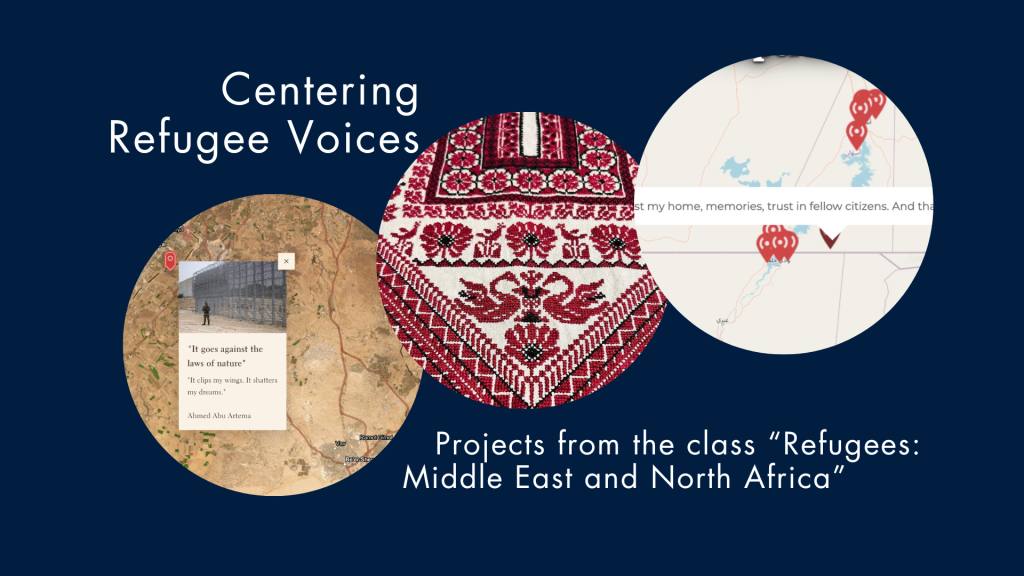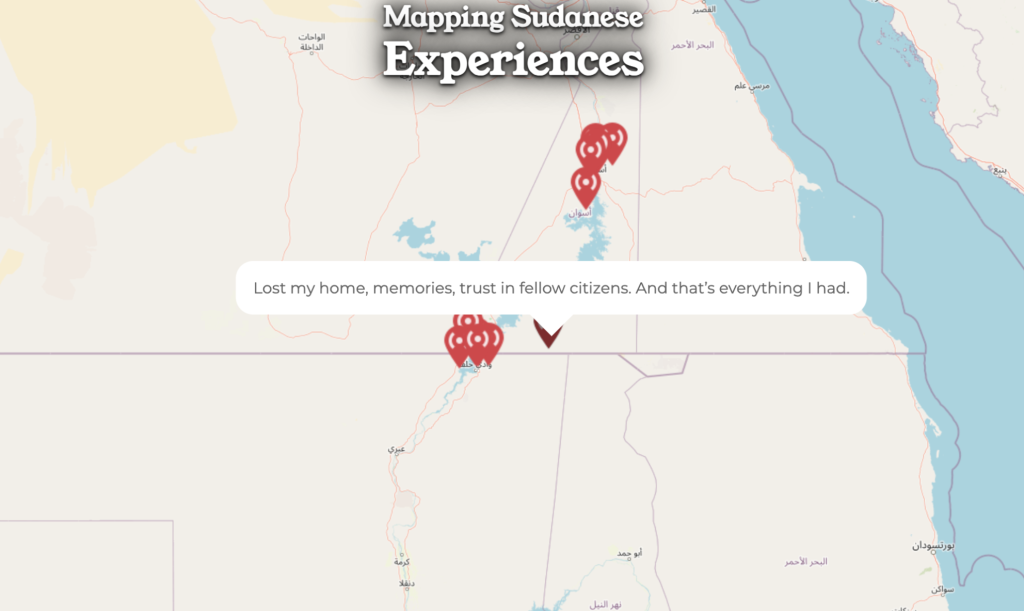By Ingie Gohar

What is the least exiled path for exiles?
What is the closest they can get to a home?
For those born into exile,
to be nothing and no one in the world
but a poet living in a house made of paper.
Refuged between pages.
Wrapped in the arms of words, keeping them warm.
Under roofs made of lines, sheltered.
~ Shano Mohammed
The above piece is part of MA in Arab Studies (MAAS) student Shano Mohammed’s collection of short stories, letters, prose, and poetry that she created as part of a final project for the MAAS course “Refugees: Middle East and North Africa.” The course, led by Professor Rochelle Davis, offers a glimpse into the struggle and resilience of refugees. The course projects were designed around 3 parts: one was a background paper on the topic chosen by the student; another was a primary source paper based on refugee “voices” whether interviews, writings, artwork, etc; and the third was a final product of their choice anchored in these two previous papers. The course enabled students to employ a variety of mediums—from poetry and digital maps to lesson plans and research papers—to highlight the diverse experiences of Palestinian poets and embroiderers, Syrian artists, Iraqi Jews who wrote memoirs, Kurds, Cypriot Maronites, recently displaced Sudanese, queer refugees, and more. At the heart of these projects is the recognition of art as a powerful tool of resistance and identity formation. A few of their projects are detailed below.

Gaza’s poetry of return
Project by Anna Wessels
Centering the voices of the people of Gaza in their ongoing struggle for liberation and justice, MAAS student Anna Wessels created an interactive story map of Palestinian poems, titled “Gaza’s Poetry of Return.” This collection shows how Palestinians in Gaza powerfully narrate their lived realities as they are egregiously robbed of their basic rights and provides a window into some of their memories, fears, dreams, and hopes. As Mahmoud Darwish wrote, “we do injustice to Gaza when we turn it into a myth.” This collection, then, shows how poetry is a powerful tool in political liberation, giving voice to the silenced and debunking myths through vivid imagery and personal narratives.
Cycles of Care
Project by Iklil Bouhmouch and Donia Khraishi
MAAS students Iklil Bouhmouch and Donia Khraishi also focused on identity formation in their video project “Cycles of Care,” which shed light on how care work shapes the identity formation and adaptation of refugees in host countries, while also preserving their connections to their home countries. This care work spans a wide range of essential activities, including caring for children, the elderly, and disabled people, alongside emotional and community support activities such as preparing meals for community gatherings.
“As a visual learner, I truly appreciated the opportunity to express the results of our research through an alternative medium,” Iklil reflected. “In addition to helping me process these ideas, creating a video or visual interpretation of information often makes your work more accessible to the communities it features.”

Embroidery, identity, and resistance among Palestinian refugee women
Project by Marium Houraney
For her project, Marium Houraney delved into the Palestinian tradition of tatreez, a form of artistic embroidery. “If you create a pattern, it is uniquely and inherently Palestinian; it tells the story you want it to tell,” founder of the Thobe Project, Samia Ayyash, told Marium. Drawing from primary sources and her own interviews, Marium reveals how this art craft has evolved to become a symbol of the Palestinian people’s resilience and pride, as well as a means for refugee Palestinian women to preserve their culture and use it as an instrument for political engagement.
Teaching units on refugees for K-12 classrooms
Project by Shauna McLean
MAAS Student Shauna McLean’s project sought to address the growing need for schools to educate students about refugees and their rights. “I think it’s really important for inclusive and well-rounded education on SWANA to start young in the US,” she said. Shauna created three interactive teaching units for K-12 classrooms, based on three books for three different grade levels. She chose Danny Ramadan’s Salma, the Syrian Chef, for elementary grades, the graphic novel When Stars are Scattered by Omar Mohamed and Victoria Jamieson for middle school, and the collection of essays edited by Malala Yousafzai titled We Are Displaced: My Journey and Stories from Refugee Girls Around the World for high school students. The goal of the project was to introduce students to the complexities of refugee experiences from those who experienced them.
The new generation of Cypriot Maronite refugees in Nicosia
Project by Max Levine
Max Levine’s project, which centered around an understudied community, examined the position of Cypriot Maronites, who do not fit neatly into the Greek Orthodox-Turkish Muslim binary in postcolonial Cyprus. “I became interested in researching how Cypriot Maronites fit into the ethnic, linguistic, religious, and cultural binaries that have divided postcolonial Cypriot society,” Max said. His research highlights the Maronites’ linguistic identity, focusing on the endangered Sanna language (Cypriot Arabic) impacted by assimilation and displacement. Post-1960s Cyprus independence, Maronites were categorized as Greek Cypriots following a referendum, as they were both Catholic. The 1974 crisis led to Maronite displacement from Northern to Southern Cyprus. During their relocation, greater emphasis was placed on Greek culture and language, which challenged Sanna preservation. Max highlights ongoing efforts to revive Maronite language and culture, particularly aimed at younger generations.
A lopsided conversation: UNHCR language and practices on queer refugees
Project by Angie Wright
Angie Wright’s research sheds light on the overlooked experiences of queer refugees from the SWANA region, critically examining the gap between UNHCR’s policies and the multi-layered realities of queer refugees. “This project, to me, begs a continuation in research, or a more committed endeavor to highlighting queer refugee experiences and voices,” Angie said. She utilizes case studies like Arsham Parsi’s, along with key UNHCR documents and queer migration theories to argue that while UNHCR’s language has evolved to acknowledge the challenges faced by queer refugees, there remains a significant gap in actual protection and support. This gap is rooted in Western-centric definitions and categorizations that can endanger and marginalize queer refugees from SWANA. Angie also highlighted that one of the challenges she faced writing this article stems from finding the voices of queer refugees from the region. “Security and protection, of course, are paramount in a queer refugee’s navigation of refugee status and the IRR. But I wonder how their voices might come to light in a safe way to educate both INGOs and the public about their experiences.”

Mapping Sudanese experiences
Project by Ingie Gohar
Maps shape how we perceive space, how our realities are shaped, and what histories and futures deserve to be represented. In her project, “Mapping Sudanese Experiences,” Ingie Gohar created a counter-narrative platform and invited Sudanese individuals who fled to Egypt following the April 15 war between the Sudanese Army and the RSF, to map out their personal journeys and experiences. By documenting and archiving their stories, the project aims to provide Sudanese refugees with a space to voice their often overlooked narratives and experiences abroad.
Refuged Between Pages: Fugitive Home(land)
Project by Shano Mohammed and Lex Grimm
Shano Mohammed and Lex Grimm created a project together about Iraqi Kurds and their history, repeated exilic experiences, and generational views on what it means to be Kurdish, including fictional pieces and poetry by Shano, like the one above. Through the intimate lens of her Kurdish identity, Shano—whose writing stands out for its raw dive into identity, uprootedness, exile, and belonging—reconstructs what it means to have a sense of home and identity, inviting us to step into the experiences of those living in exile and statelessness.
A new perspective on refugee experiences
Collectively, these projects serve as an archive of the experiences of refugees who have been forced to flee their countries and rebuild their lives in a foreign one. Through poetry, art, videos, research, and more, the projects of the students in the “Refugees: Middle East and North Africa” course help to bring these stories to light, offering new ways to understand and connect with the experiences of refugees—experiences that news headlines and statistics alone cannot reveal.
Ingie Gohar is a first-year student in the MAAS program from Giza, Egypt.